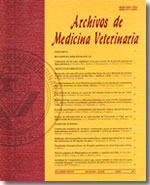Evaluation of an endovenous ketamine infusion through computed tomography on the development of pulmonary atelectasis due to general anesthesia in dogs
Main Article Content
Abstract
The aim of this study was to assess through computed tomography the presence of pulmonary atelectasis in dogs under inhalatory anesthesia and evaluate the effect of an endovenous ketamine infusion upon it. For this purpose 12 dogs separated in two groups (A and B) of 6 dogs each were used. Both groups were subjected to the same anesthetic protocol. The protocol consisted in premedication with xilacine IM, induction with propofol IV and maintenance with inhalatory anesthesia for a period of two hours. The group B received also a ketamine infusion. Computed tomographic images were taken at 0, 60 and 120 minutes, with the purpose of monitoring developments of atelectasis. In 58% of the dogs it was possible to determine the presence of some degree of atelectasis. In these animals atelectasis was observed in all the cases, but only in one lung. Atelectasis was found in 5 animals in the group without infusion of ketamine and in 2 animals in the group with infusion. The collapsed lung zones ranged between 0.13 and 8.03 cm2 in group A, and 0.07 and 2.10 cm2 in group B. Results indicated that ketamina infusion did not influence the presentation of pulmonary atelectasis. With regard to the evolution of the atelectasis through time, slight changes were observed in both groups, not being statistically significant (P > 0.05).

